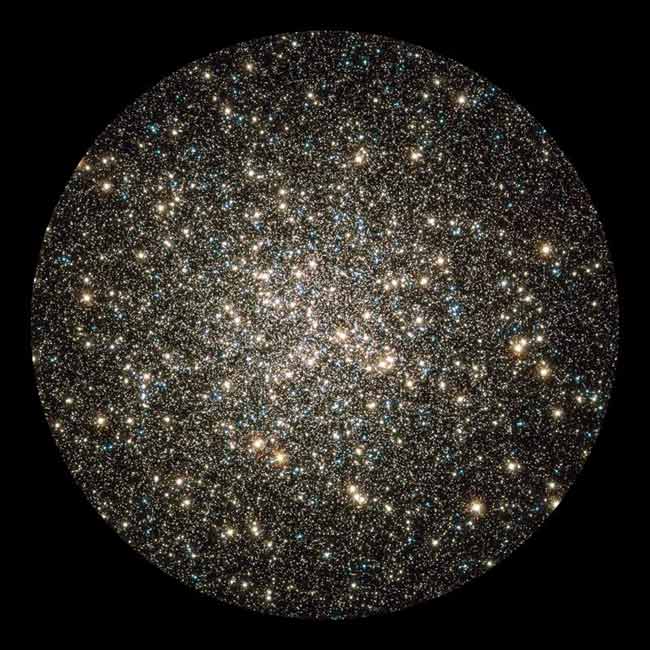Hubble Sees a Celestial 'Snow Globe'

Like awhirl of shiny flakes sparkling in a snow globe, many hundreds of thousands ofstars move about in the globular cluster M13, as Hubble catches aninstantaneous glimpse of one of the brightest and best-known globular clustersin the northern sky. This glittering metropolis of stars is easily found in thewinter sky in the constellation Hercules, and can even be glimpsed with theunaided eye under dark skies.
M13 is hometo over 100,000 stars and located ata distance of 25,000 light-years. These stars are packed so closely together ina ball approximately 150 light-years across that they will spend their entirelives whirling around in the cluster.
Near thecore of this cluster, the density of stars is about a hundred times greaterthan the density in the neighborhood of our sun. These stars are so crowdedthat they can, at times, slam into each other and even form a new star, calleda "bluestraggler."
Thebrightest reddish stars in the cluster are ancient red giants. These agingstars have expanded to many times their original diameters and cooled. Theblue-white stars are the hottest in the cluster.
Globularclusters can be found spread largely in a vast halo around our galaxy. M13 isone of nearly 150 known globular clusters surrounding our Milky Way galaxy.
Globularclusters have some of the oldest stars in the universe. They likely formedbefore the disk of our Milky Way, so they are older than nearly all other starsin our galaxy. Studying globular clusters therefore tells us about the historyof our galaxy.
This imageis a composite of archival Hubbledata taken with the Wide Field Planetary Camera 2 and the Advanced Camera forSurveys. Observations from four separate science proposals taken in November 1999,April 2000, August 2005 and April 2006 were used. The image includes broadbandfilters that isolate light from the blue, visible and infrared portions of thespectrum.
Breaking space news, the latest updates on rocket launches, skywatching events and more!
- Video - Hubble Video: See Mars Rotate
- Video - Hubble Refurb Retrospective
- Video - Star Cluster Close-Up

Space.com is the premier source of space exploration, innovation and astronomy news, chronicling (and celebrating) humanity's ongoing expansion across the final frontier. Originally founded in 1999, Space.com is, and always has been, the passion of writers and editors who are space fans and also trained journalists. Our current news team consists of Editor-in-Chief Tariq Malik; Editor Hanneke Weitering, Senior Space Writer Mike Wall; Senior Writer Meghan Bartels; Senior Writer Chelsea Gohd, Senior Writer Tereza Pultarova and Staff Writer Alexander Cox, focusing on e-commerce. Senior Producer Steve Spaleta oversees our space videos, with Diana Whitcroft as our Social Media Editor.
